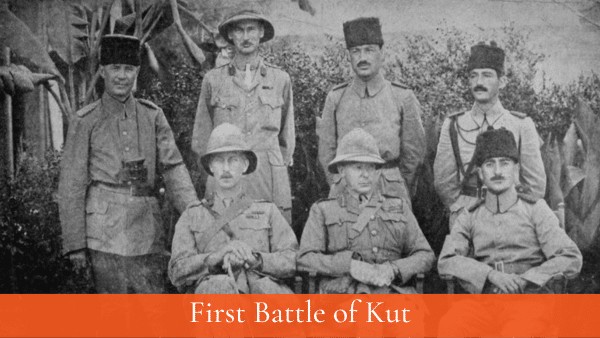The First Battle of Kut, which began on April 5, 1916, was the final British attempt to relieve the Turkish siege of Kut in World War 1, where 10,000 British troops under the command of Sir Charles Townshend were trapped.

The failure of the battle sealed the fate of Townshend's force, which surrendered unconditionally to Turkish commander Khalil Pasha on April 29, 1916, after running out of supplies.
Jump to:
Prelude
The newly arrived British commander George Gorringe, who was unpopular with the troops, took over from the recalled Sir Fenton Aylmer to lead the operation to relieve Kut.
Gorringe's force was boosted by the recent arrival of Sir Frederick Maude's 13th Division, which brought his available strength up to around 30,000. Khalil Pasha, the Turkish commander, matched this number by drafting up reserves from nearby Baghdad.
Gorringe decided to attack the Hanna Defile once again, even though it had been unsuccessful in January 1916. In the meantime, Khalil Pasha had established two deep trench lines at Fallahiyeh and Sannaiyat.
The Battle
Maude attacked at dawn on April 5 and was surprised to find that the Turkish first line was unoccupied. He regrouped and attacked Fallahiyeh that evening.
The British took Fallahiyeh after advancing across mud-soaked terrain but at a high cost.
Meanwhile, a secondary attack along the other bank of the Tigris River encountered relatively light opposition. With Fallahiyeh secured, reserve forces were set in place in preparation for a follow-up attack against Sannaiyat the next morning.
Despite these early promising British successes, casualties were nevertheless uncomfortably high: 2,000 on the first day alone.
Progress was much more difficult to come by on the following morning. Attack after attack upon Sannaiyat was repulsed over succeeding days.
1,200 British casualties were incurred alone on April 6, with additional losses suffered the next day and on April 9.
Frustrated in his attacks against Sannaiyat, General Gorringe resolved, therefore, to switch the focus of his main attack to the other bank against the Turk-held Bait Asia position.
Heavy rainfall, however, hindered Gorringe's advance. Nevertheless, forward Turk positions fell on April 15, with Bait Asia itself falling on April 17 at a relatively light cost.
Khalil Pasha launched a determined counter-attack with 10,000 troops overnight against the Anglo-Indian forces at Bait Asia but was ultimately thrown back. Khalil's force suffered a high percentage of casualties: 4,000; however, the British loss of 1,600 troops made further progress along the bank virtually impossible.
Despite the absence of around 5,000 reserves en route to Gorringe from the British HQ at Basra, General Gorringe nevertheless launched a final attempt on April 22, switching his focus back again to Sannaiyat.
However, the attack was poorly composed. It consisted of a single brigade preceded by the usual artillery bombardment, which warned the Turks of the impending attack.
The attack was repulsed after Khalil first evacuated his first two lines and then counter-attacked in force. A further 1,300 British casualties were suffered in this latest setback, bringing the overall total during relief operations to 23,000.
Aftermath
No further attempts were made to relieve Kut, save for a final, failed effort to send supplies through via an armored supply ship, the Julnar.
Sir Charles Townshend, having consulted with higher authority, surrendered unconditionally on April 29, 1916, after failing to purchase parole for his 10,000 men with an offer of 1 million pounds.
This was the greatest humiliation to have befallen the British army in its history. For the Turks and Germany, it proved to be a significant morale booster and undoubtedly weakened British influence in the Middle East.
In the wake of what was perceived in London as a calamity, Maude replaced General Gorringe as commander of the so-called Tigris Corps in July 1916, marking a shift in control from India to Britain. The following month, he was given responsibility for the entire front.
He immediately set about reorganizing and resupplying British and Indian forces in the region. He rapidly established a reputation as the most successful commander - of either side - operating on the Mesopotamian Front.
